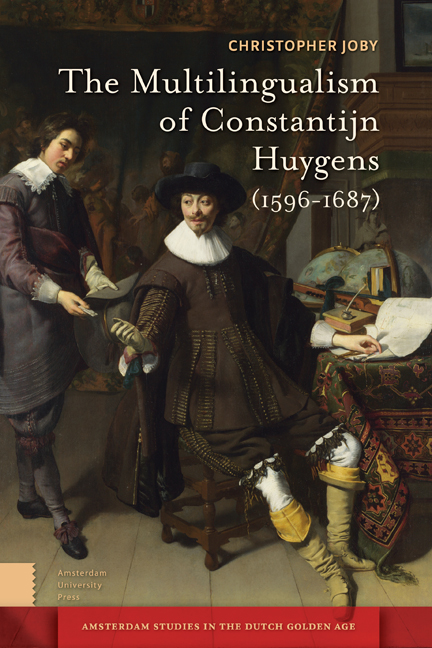Book contents
- Frontmatter
- Dedication
- Contents
- List of Illustrations
- List of Abbreviations
- Acknowledgements
- Prologue
- 1 Multilingualism: An Introduction
- 2 Huygens’s Language Acquisition
- 3 The ‘Multidimensionality’ of Huygens’s Multilingualism
- 4 Huygens’s Multilingualism in Music, Science, and Architecture
- 5 Huygens and Translation
- 6 Code Switching in Huygens’s work
- 7 The Multilingualism of Huygens’s Children
- Epilogue
- Appendix
- Bibliography
- Index
3 - The ‘Multidimensionality’ of Huygens’s Multilingualism
Published online by Cambridge University Press: 16 February 2021
- Frontmatter
- Dedication
- Contents
- List of Illustrations
- List of Abbreviations
- Acknowledgements
- Prologue
- 1 Multilingualism: An Introduction
- 2 Huygens’s Language Acquisition
- 3 The ‘Multidimensionality’ of Huygens’s Multilingualism
- 4 Huygens’s Multilingualism in Music, Science, and Architecture
- 5 Huygens and Translation
- 6 Code Switching in Huygens’s work
- 7 The Multilingualism of Huygens’s Children
- Epilogue
- Appendix
- Bibliography
- Index
Summary
In this chapter the various ways in which Huygens employed his multilingualism will be discussed. We saw in the last chapter that at its core this multilingualism consisted of eight languages: Dutch, French, Latin, Greek, Italian, English, Spanish, and German. Others in the Dutch Republic knew more languages, such as his correspondent, Anna Maria van Schurman (see Chapter 1), or knew different languages, such as Theodore Rodenburgh, who could write in Portuguese (Chapter 2). However, what marks Huygens out is first that a vast amount of material survives, including two significant autobiographical texts, which allows us to study his multilingualism; and second, the sheer range of activities in which he employed his knowledge of languages. We have already seen that he wrote many, in fact thousands, of letters, and he employed his knowledge of each of his eight core languages in his correspondence. Furthermore, he wrote many thousands of poems in these languages, and here we may contrast him with a multilingual such as Carolus Clusius (see Chapter 1), who, though at least Huygens's equal in the range of languages he knew and used, did not, as far as I have been able to establish, publish poetry in these languages and certainly not to the same extent as Huygens.
In what follows we begin by considering how Huygens expressed his multilingualism in both his correspondence and his verse. Other ways in which Huygens used his multilingual skills are then discussed. An important part of Huygens's multilingualism was his use of quotations. He drew in particular on Ancient Greek and Latin sources, a practice that can be seen as part of the humanist enterprise of imitatio. Consideration will be given to the various ways in which Huygens inserted quotations into his work. Apart from the eight languages which formed the core of Huygens's multilingualism, he also engaged with a number of other languages to a limited extent. Brief consideration will be given to how he did this. The conjunction of Huygens's multilingualism and sense of humour provides rich material for this study. Two ways in which this manifested itself are his use of Dutch dialects and his coining of neologisms in a number of languages. Mention has already been made of the problems associated with studying Huygens's spoken use of language.
- Type
- Chapter
- Information
- The Multilingualism of Constantijn Huygens (1596–1687) , pp. 83 - 136Publisher: Amsterdam University PressPrint publication year: 2014



